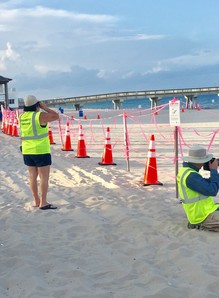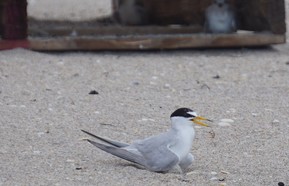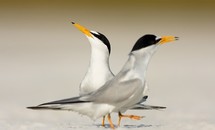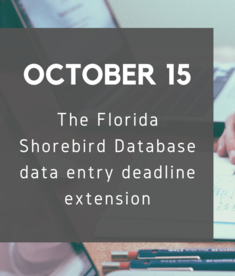FSA Partnership Meetings
(post-season meetings will be held virtually)
October 1: Volusia Partnership, 1-3:30pm; Contact Jennifer Winters.
October 5: Nature Coast Partnership, 1-4pm; Contact Megan Wallrichs.
October 8: Panhandle Working Group, 9am-12pm (central). Contact Bonnie Samuelsen.
October 8: Suncoast Partnership, 12-3pm. Contact Holley Short.
October 9: Space Coast Partnership, 12-3pm. Contact Anna Deyle.
October 15: St. Johns/Flagler Partnership, 1pm. Contact Jean Olbert.
October 28: Treasure Coast Partnership, 10am-12pm. Contact Niki Desjardin.
October 29: Timucuan Partnership, 10am. Contact Jean Olbert.
Events
October 15: FSD Data Entry Deadline
October 20-24: Audubon Florida Virtual Assembly

Least terns nest in Deerfield Beach
-Olivia Rothberg
Deerfield Beach, located in Broward County, is a popular and lively destination among locals and tourists alike. However, unprecedented beach closures in the spring allowed some original inhabitants to return. In early March, State-threatened least terns found their home on Deerfield’s sandy shores, just south of the International Fishing Pier. With minimal disturbance from people and pets, the birds were able to establish a successful colony there for the first time in recorded history! Staff with the Florida Fish and Wildlife Conservation Commission immediately posted signs and symbolic fencing around the colony to safeguard the nesting birds.
The biggest issues these birds face is habitat loss and human disturbance, with an 80% decline in their population over the last 40 years. As beaches have become more developed, these seabirds have been pushed out of their natural habitat, and now can often be found nesting on gravel roofs nearby. In fact, Deerfield Beach was the only known successful least tern colony at a beach in 2020 on Florida’s entire southeast coast and in the Keys, garnering it some well-deserved attention.
|

As the beach reopened in May and crowds returned, the colony was at risk of abandonment. Despite challenging circumstances, intensive safeguarding efforts by biologists with FWC ensured that a large, usually popular section of the public beach remained closed for the nesting birds. The posted area was essential to the colony’s success and was closely monitored by volunteer beach stewards with the Florida Shorebird Alliance from dawn to dusk. The team of volunteer stewards educated beach-goers of the importance of this historic nesting event, while preventing people, animals, and stray volleyballs from entering the site and accidently crushing nests or chicks. The birds were such a hit with the public, that on July 7th, the Least Tern became the official bird of the city of Deerfield Beach.
|

The beginning of August concluded the least tern nesting season in south Florida and the posted area of the beach was reopened. Thanks to heroic efforts from volunteers with the Florida Shorebird Alliance, FWC, and the city of Deerfield, the beach this year was home to 120 adults and produced 75 chicks! While the birds are unlikely to return next year without re-closing the public beaches, the least tern made a lasting impression on this community, instilling the importance of beach stewardship to protect Florida’s native wildlife.
Photo of volunteers looking into the posted least tern colony by Ann Wiley.
Photos of incubating least tern adult and fledged least tern chicks by Andrea Pereyra.
|

Seabird abundance estimates webinar replay
If you were not able to attend the seabird abundance estimates webinar on September 17, don’t worry! The webinar was recorded and is now available for viewing on YouTube: https://www.youtube.com/watch?v=qwy8mcD_df4.
In the webinar, the FWC shorebird data team presents a method for estimating abundance of least terns and black skimmers in Florida using data from the Florida Shorebird Database (FSD). If you have any questions, please email FLShorebirdDatabase@myFWC.com. Thank you for your interest in Florida’s seabirds!
Photo by Maxis Gamez
|


FSD data entry deadline extension
The 2020 shorebird and seabird breeding season has come to a close. We know how unusual this season was for many partners, and we know some partners still need more time to enter data.
This year's data entry deadline will be Thursday, October 15th. We hope that extending the typical October 1st deadline by two weeks will give you enough time to finish entering data into the Florida Shorebird Database (FSD). Remember, all surveys contribute valuable information - even if the survey didn't occur during a count window this year.
Completing data entry by the 15th makes it possible for YOUR data to be included in summaries for the rest of the post-season partnership meetings, and into our long-term analyses.
Data entry checklist:
- Route surveys – Have I entered all my surveys, even the surveys when I didn’t see nesting birds?
- Shorebird nests – Did I enter every shorebird nest I observed? Do they all have a final outcome?
- Seabird colonies – Did I enter every seabird colony I observed? Do they all have a final outcome?
- Roving shorebird chicks – Did I enter every shorebird chick that I observed out of its nest? Did I include its natal nest information? Does its natal nest show a final outcome of “Complete”?
- Staging seabird young – Have I entered my sightings of flight-capable seabird young away from their colonies?
- All rooftop surveys – Have I entered all my surveys, even the surveys when I didn’t see or hear birds? If my rooftops had nesting activity, do they all have a final outcome?
In the coming weeks, the data quality control team will be reviewing records and reaching out for any clarifications needed. This is part of the annual process of making sure the team understands every observation entered.
If you have any questions or need assistance, please email us; we are happy to help! As always, if you experience any malfunctions with the FSD website, we encourage you to report them. Your feedback helps us create a better website.
Thank you for being an essential partner in the shorebird monitoring program!
|
|